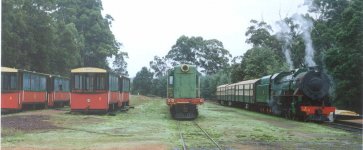teddy
Duckmeister
Corris Railway
In December 1966 a group of Talyllyn Railway Preservation Society members from the East Midlands formed what became The Corris Railway Society, with four goals :
The Corris Railway was the first Narrow Gauge railway in Mid-Wales. Built originally in 1859 as a 2' 3" gauge horse-hauled tramroad, steam locomotives arrived in 1878 and passengers were carried from 1883 to 1930. The Railway closed in 1948 and was dismantled soon afterwards.
The Corris Railway Museum opened in 1970 and passenger services recommenced in 2002, with regular steam-hauled services returning in 2005, operated by volunteer members of the Corris Railway Society.
The round trip taking 50 minutes, including a guided tour of the 135-year old engine shed and workshops at Maespoeth. No single tickets are issued as under planning requirements all journeys must start and end at Corris Station.

A modern version of the Kerr Stuart Tattoo class delivered in 2005
To build another Tattoo might be considered sensible because the design had been accepted by HMRI, but the opportunity to build a locomotive which would closely resemble the original Corris No.3, a Falcon, although fraught with difficulties, was an opportunity not to be missed. To have an appropriately modernised replica of a Falcon would be an advantage to give the railway variety in motive power. Our photo charter friends would love it, the visual display would be more satisfying than two identical twins and it would improve the profile of the railway as a national tourist attraction.
There are plans to extend the line and fund raising is in progress

teddy
In December 1966 a group of Talyllyn Railway Preservation Society members from the East Midlands formed what became The Corris Railway Society, with four goals :
The Corris Railway was the first Narrow Gauge railway in Mid-Wales. Built originally in 1859 as a 2' 3" gauge horse-hauled tramroad, steam locomotives arrived in 1878 and passengers were carried from 1883 to 1930. The Railway closed in 1948 and was dismantled soon afterwards.
The Corris Railway Museum opened in 1970 and passenger services recommenced in 2002, with regular steam-hauled services returning in 2005, operated by volunteer members of the Corris Railway Society.
The round trip taking 50 minutes, including a guided tour of the 135-year old engine shed and workshops at Maespoeth. No single tickets are issued as under planning requirements all journeys must start and end at Corris Station.

A modern version of the Kerr Stuart Tattoo class delivered in 2005
To build another Tattoo might be considered sensible because the design had been accepted by HMRI, but the opportunity to build a locomotive which would closely resemble the original Corris No.3, a Falcon, although fraught with difficulties, was an opportunity not to be missed. To have an appropriately modernised replica of a Falcon would be an advantage to give the railway variety in motive power. Our photo charter friends would love it, the visual display would be more satisfying than two identical twins and it would improve the profile of the railway as a national tourist attraction.
There are plans to extend the line and fund raising is in progress

teddy
Last edited:










